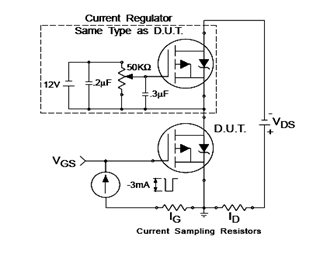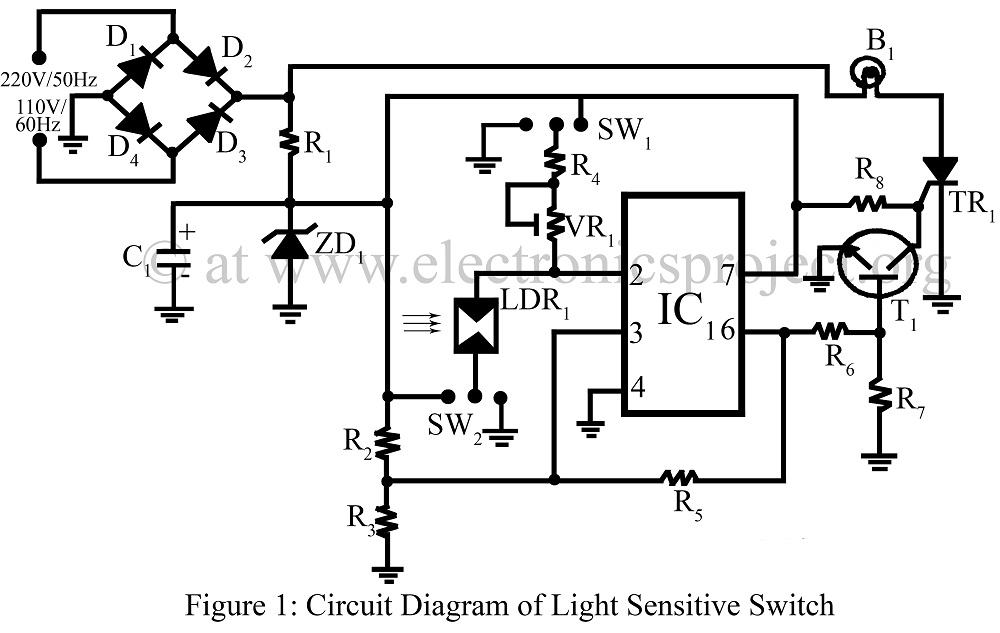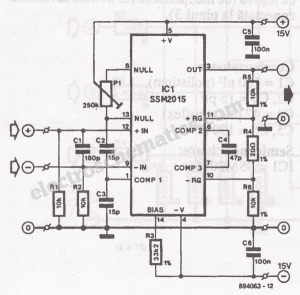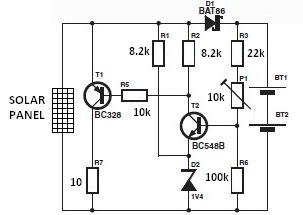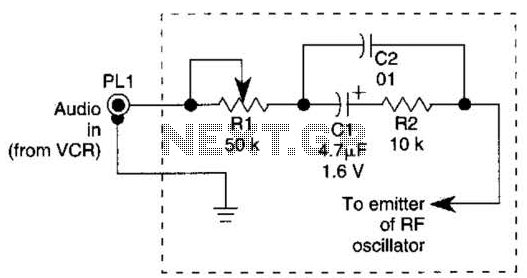
emergency light circuit diagram

The automatic emergency light circuit has the following features: 1. When the mains supply (230V AC) is available, it charges a 12V battery up to 13.5V, after which the battery is disconnected from the charging section. 2. When the battery discharges to 10.2V, it is disconnected from the load, and the charging process resumes. 3. If the mains voltage is available and there is darkness in the room, the load (bulb or tube) is powered by the mains; otherwise, the battery is connected to the load. 4. If the battery discharges to 10.2V and the mains is unavailable, the battery is completely disconnected from the circuit to prevent further discharge. The 230V AC mains supply is stepped down to 18V AC (RMS) using a transformer (X1) with a primary of 230V AC and a secondary of 0-18V AC, 2A, typically used in 36cm B&W TVs. Diodes D1 through D4 form a bridge rectifier, and capacitor C5 filters the voltage, providing approximately 25V DC at the output. The charging section includes a 33-ohm, 10-watt resistor (R2) that limits the charging current to about 425 mA when the battery voltage is approximately 10.2V, or to 325 mA when the battery voltage reaches 13.5V. When the battery charges to 13.5V (as set by VR2), the zener diode (D17) enters the breakdown region, triggering triac (TR1). The triac remains continuously on even if the gate current is reduced to zero. Once the battery is fully charged, the charging section is disconnected from the battery due to the energization of relay (RL2). This relay remains on even if power fails due to the connection to the battery via diode D10. A normally closed switch (S4) is included to manually restart the charging process if needed. The battery disconnect and charging restart section comprises an NE555 timer (IC2) wired in monostable mode. When the battery voltage is above 10.2V (indicated by red LED D15), the zener diode (D16) remains in the breakdown region, keeping the trigger pin 2 of IC2 high and maintaining output pin 3 in a low voltage state. Thus, relay (RL3) is activated, and relay (RL4) remains off. When the battery voltage falls to about 10.2V (as set by preset VR1), zener diode D16 ceases conduction, making pin 2 low and pin 3 high, turning on relay (RL4) and orange LED (D13), while switching off relay (RL3) and LED (D15). If mains power is available, charging restarts due to the de-energization of relay (RL2) as relay (RL4) breaks the circuit of relay (RL2) and triac (TR1). However, if the mains supply is absent, both relays (RL3) and (RL1) de-energize, disconnecting the battery from the remaining circuit, preventing further discharge. When mains supply resumes, it energizes relay (RL1), reconnecting the battery to the circuit. The light sensor section also uses a 555 timer IC in monostable mode. While normal light is present, the resistance of LDR1 is low, keeping pin 2 of IC3 near Vcc and its output at pin 3 low. In darkness, LDR resistance increases, causing pin 2 of IC3 to drop near ground potential and trigger it. Consequently, output pin 3 goes high during the monostable pulse period, forward-biasing transistor (T3) into saturation, energizing relay (RL5). With the auto/bypass switch (S2) off (in auto mode), the load connects to the supply via switch (S3). The load can be switched during the daytime by setting switch (S2) to the on position (manual). Preset (VR3) serves as the sensitivity control for setting the threshold light level at which the load is automatically switched on/off. Capacitors with the relays prevent chattering. When mains power is present, diode (D8) couples the input voltage to regulator IC1, while diode (D10) feeds the input voltage from the battery in the absence of mains supply. Diode (D5) connects the load to the power supply section via resistor (R5) when mains power is available (diode D18 does not conduct). Conversely, when mains power fails, diode (D18) conducts while diode (D5) does not. The load can be any 12V bulb with a maximum current rating of 2 amperes (24 watts). Resistor (R5) is designed to drop approximately 12 volts when the load current flows through it during mains availability, resulting in power dissipation nearly equal to the load power. It is advisable to replace (R5) with a bulb of similar voltage and wattage as the load, ensuring more (double) light during mains availability compared to battery power. For setting presets (VR1) and (VR2), remove (desolder one end of) diodes (D7), (D10), and (D18). Connect a variable power supply in place of the battery. Adjust preset (VR1) until battery-high LED (D15) turns off at 10.2V of the variable source. Increase the variable source voltage and observe the transition from LO BAT LED (D13) to (D15). Set the variable source to 13.5V and adjust preset (VR2) until relay (RL2) just energizes. Gradually decrease the voltage, ensuring relay (RL2) remains energized above 10.2V. At 10.2V, LED (D15) should turn off, relay (RL2) should de-energize, and LED (D13) should light up. Preset (VR3) can be adjusted during evening hours to ensure the load operates under desired light conditions.The circuit of automatic emergency light presented here has the following features: 1. When the mains supply (230V AC) is available, it charges a 12V battery up to 13. 5V and then the battery is disconnected from the charging section. 2. When the battery discharges up to 10. 2V, it is disconnected from the load and the charging process is resumed. 3 . If the mains voltage is available and there is darkness in the room, load (bulb or tube) is turned on by taking power from the mains; otherwise the battery is connected to the load. 4. When the battery discharges up to 10. 2V and if the mains is not yet available, the battery is completely disconnected from the circuit to avoid its further discharge.
The mains supply of 230V AC is stepped down to 18V AC (RMS) using a 230V AC primary to 0-18V AC, 2A secondary transformer (X1), generally used in 36cm B&W TVs. Diodes D1 through D4 form bridge rectifier and capacitor C5 filters the voltage, providing about 25V DC at the output.
Charging section includes 33-ohm, 10-watt resistor R2 which limits the charging current to about 425 mA when battery voltage is about 10. 2V, or to 325 mA when battery voltage is about 13. 5V. When the battery charges to 13. 5V (as set by VR2), zener diode D17 goes into breakdown region, thereby triggering triac TR1. Now, since DC is passing through the triac, it remains continuously on even if the gate current is reduced to zero (by disconnecting the gate terminal).
Once the battery is fully charged, charging section is cut-off from the battery due to energisation of relay RL2. This relay remains on even if the power fails because of connection to the battery via diode D10. S4, a normally closed switch, is included to manually restart the charging process if required. Battery disconnect and charging restart section comprises an NE555 timer (IC2) wired in monostable mode.
When the battery voltage is above 10. 2V (as indicated by red LED D15), zener diode (D16) remains in the breakdown region, making the trigger pin 2 of IC2 high, thereby maintaining output pin 3 in low voltage state. Thus, relay RL3 is on and relay RL4 is off. But as soon as the battery voltage falls to about 10. 2V (as set by preset VR1), zener diode D16 comes out of conduction, making pin 2 low and pin 3 high to turn on relay RL4 and orange LED D13.
This also switches off relay RL3 and LED D15. Now, if the mains is available, charging restarts due to de-energisation of relay RL2 because when relay RL4 is on, it breaks the circuit of relay RL2 and triac TR1. But if the mains supply is not present, both relays RL3 and RL1 de-energise, disconnecting the battery from the remaining circuit.
Thus when battery voltage falls to 10. 2 volts, its further discharge is eliminated. But as soon as the mains supply resumes, it energises relay RL1, thereby connecting the battery again to the circuit. Light sensor section also makes use of a 555 timer IC in the monostable mode. As long as normal light is falling on LDR1, its resistance is comparatively low. As a result pin 2 of IC3 is held near Vcc and its output at pin 3 is at low level. In darkness, LDR resistance is very high, which causes pin 2 of IC3 to fall to near ground potential and thus trigger it.
As a consequence, output pin 3 goes high during the monostable pulse period, forward biasing transistor T3 which goes into saturation, energising relay RL5. With auto/bypass switch S2 off (in auto mode), the load gets connected to supply via switch S3. If desired, the load may be switched during the day-time by flipping switch S2 to on position (manual).
Preset VR3 is the sensitivity control used for setting threshold light level at which the load is to be automatically switched on/off. Capacitors with the relays ensure that there is no chattering of the relays. When the mains is present, diode D8 couples the input voltage to regulator IC1 whereas diode D10 feeds the input voltage to it (from battery) in absense of mains supply.
Diode D5 connects the load to the power supply section via resistor R5 when mains is available (diode D18 does not conduct). However, when mains power fails, the situation reverses and diode D18 conducts while diode D5 does not conduct.
. The load can be any bulb of 12 volts with a maximum current rating of 2 amperes (24 watts). Resistor R5 is supposed to drop approximately 12 volts when the load current flows through it during mains availability. Hence power dissipated in it would almost be equal to the load power. It is therefore desirable to replace R5 with a bulb of similar voltage and wattage as the load so that during mains availability we have more (double) light than when the load is fed from the battery.
For setting presets VR1 and VR2, just take out (desolder one end) diodes D7, D10 and D18. Connect a variable source of power supply in place of battery. Set preset VR1 so that battery-high LED D15 is just off at 10. 2V of the variable source. Increase the potential of the variable source and observe the shift from LO BAT LED D13 to D15. Now make the voltage of the source 13. 5V and set preset VR2 so that relay RL2 just energises. Then decrease the voltage slowly and observe that relay RL2 does not de-energise above 10. 2V. At 10. 2V, LED D15 should be off and relay RL2 should de-energise while LED D13 should light up. Preset VR3 can be adjusted during evening hours so that the load is on during the desired light conditions Disclaimer: All the information present on this site are for personal use only. No commercial use is permitted without the prior permission from authors of this website. All content on this site is provided as is and without any guarantee on any kind, implied or otherwise.
We cannot be held responsible for any errors, omissions, or damages arising out of use of information available on this web site. The content in this site may contain COPYRIGHTED information and should not be reproduced in any way without prior permission from the authors.
🔗 External reference
The mains supply of 230V AC is stepped down to 18V AC (RMS) using a 230V AC primary to 0-18V AC, 2A secondary transformer (X1), generally used in 36cm B&W TVs. Diodes D1 through D4 form bridge rectifier and capacitor C5 filters the voltage, providing about 25V DC at the output.
Charging section includes 33-ohm, 10-watt resistor R2 which limits the charging current to about 425 mA when battery voltage is about 10. 2V, or to 325 mA when battery voltage is about 13. 5V. When the battery charges to 13. 5V (as set by VR2), zener diode D17 goes into breakdown region, thereby triggering triac TR1. Now, since DC is passing through the triac, it remains continuously on even if the gate current is reduced to zero (by disconnecting the gate terminal).
Once the battery is fully charged, charging section is cut-off from the battery due to energisation of relay RL2. This relay remains on even if the power fails because of connection to the battery via diode D10. S4, a normally closed switch, is included to manually restart the charging process if required. Battery disconnect and charging restart section comprises an NE555 timer (IC2) wired in monostable mode.
When the battery voltage is above 10. 2V (as indicated by red LED D15), zener diode (D16) remains in the breakdown region, making the trigger pin 2 of IC2 high, thereby maintaining output pin 3 in low voltage state. Thus, relay RL3 is on and relay RL4 is off. But as soon as the battery voltage falls to about 10. 2V (as set by preset VR1), zener diode D16 comes out of conduction, making pin 2 low and pin 3 high to turn on relay RL4 and orange LED D13.
This also switches off relay RL3 and LED D15. Now, if the mains is available, charging restarts due to de-energisation of relay RL2 because when relay RL4 is on, it breaks the circuit of relay RL2 and triac TR1. But if the mains supply is not present, both relays RL3 and RL1 de-energise, disconnecting the battery from the remaining circuit.
Thus when battery voltage falls to 10. 2 volts, its further discharge is eliminated. But as soon as the mains supply resumes, it energises relay RL1, thereby connecting the battery again to the circuit. Light sensor section also makes use of a 555 timer IC in the monostable mode. As long as normal light is falling on LDR1, its resistance is comparatively low. As a result pin 2 of IC3 is held near Vcc and its output at pin 3 is at low level. In darkness, LDR resistance is very high, which causes pin 2 of IC3 to fall to near ground potential and thus trigger it.
As a consequence, output pin 3 goes high during the monostable pulse period, forward biasing transistor T3 which goes into saturation, energising relay RL5. With auto/bypass switch S2 off (in auto mode), the load gets connected to supply via switch S3. If desired, the load may be switched during the day-time by flipping switch S2 to on position (manual).
Preset VR3 is the sensitivity control used for setting threshold light level at which the load is to be automatically switched on/off. Capacitors with the relays ensure that there is no chattering of the relays. When the mains is present, diode D8 couples the input voltage to regulator IC1 whereas diode D10 feeds the input voltage to it (from battery) in absense of mains supply.
Diode D5 connects the load to the power supply section via resistor R5 when mains is available (diode D18 does not conduct). However, when mains power fails, the situation reverses and diode D18 conducts while diode D5 does not conduct.
. The load can be any bulb of 12 volts with a maximum current rating of 2 amperes (24 watts). Resistor R5 is supposed to drop approximately 12 volts when the load current flows through it during mains availability. Hence power dissipated in it would almost be equal to the load power. It is therefore desirable to replace R5 with a bulb of similar voltage and wattage as the load so that during mains availability we have more (double) light than when the load is fed from the battery.
For setting presets VR1 and VR2, just take out (desolder one end) diodes D7, D10 and D18. Connect a variable source of power supply in place of battery. Set preset VR1 so that battery-high LED D15 is just off at 10. 2V of the variable source. Increase the potential of the variable source and observe the shift from LO BAT LED D13 to D15. Now make the voltage of the source 13. 5V and set preset VR2 so that relay RL2 just energises. Then decrease the voltage slowly and observe that relay RL2 does not de-energise above 10. 2V. At 10. 2V, LED D15 should be off and relay RL2 should de-energise while LED D13 should light up. Preset VR3 can be adjusted during evening hours so that the load is on during the desired light conditions Disclaimer: All the information present on this site are for personal use only. No commercial use is permitted without the prior permission from authors of this website. All content on this site is provided as is and without any guarantee on any kind, implied or otherwise.
We cannot be held responsible for any errors, omissions, or damages arising out of use of information available on this web site. The content in this site may contain COPYRIGHTED information and should not be reproduced in any way without prior permission from the authors.
🔗 External reference
